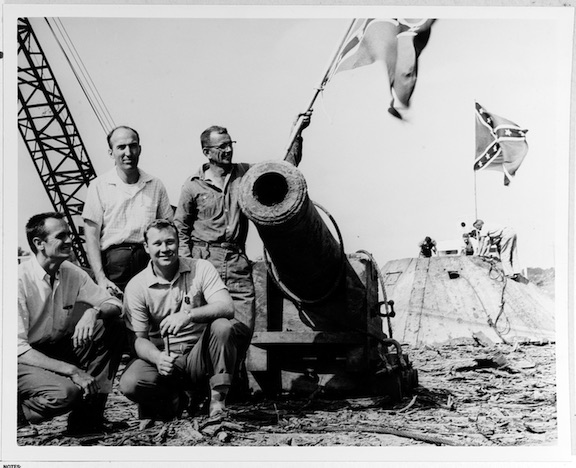Stars and Bearss
 While searching for some Vicksburg-related images at the Naval History and Heritage Command website today, I came across this photo from salvage operations for the USS Cairo. The Cairo hit a mine in the Yazoo River on December 12, 1862, and went down in 12 minutes in 36 feet of water with no casualties.
While searching for some Vicksburg-related images at the Naval History and Heritage Command website today, I came across this photo from salvage operations for the USS Cairo. The Cairo hit a mine in the Yazoo River on December 12, 1862, and went down in 12 minutes in 36 feet of water with no casualties.
In 1959, Ed Bearss, historian at Vicksburg National Military Park, along with colleagues Warren Grabau and Don Jacks, located the Cairo, and salvage efforts began the following year. The full ship came up in late 1964, but prior to that, archeologists salvaged a number of items. The naval cannon, photographed above, was salvaged in 1961. Ed Bearss, in the white shirt, kneels in the front row.
The photo, taken by Ed McHale for the Vicksburg Evening Post, was captioned: “
The series features several other images of various groups of men clustered around the same cannon.
My ECW colleague Dwight Hughes turned me on to the marvelous–and overlooked–collection at Naval History and Heritage Command. We tapped into it extensively for Civil War on the Water, part of the ECW 10th Anniversary Series. They have a ton of photos from the Cairo’s salvage operations, so if you want to see more, click here and search “Cairo + salvage operations.” (https://www.history.navy.mil/our-collections/photography.html)
For more on the story of the Cairo and its salvage, visit Vicksburg National Military Park’s Cairo page.

Chris, did you ever hear Ed’s story on how the money for raising the Cairo was ultimately raised? He shared it at the Rappahannock Valley Civil War Roundtable years ago. It was a corker.
Wonderful photos and background story on the raising of the sunken Union ship. Seeing Ed Bearss prominently posing with other members of the salvage team reminded me of a recent episode of a podcast called “The Unauthorized History of the Pacific War” that I viewed explaining how, Ed, as a young Marine , was severely wounded in Operation Backhander, which was the American Military campaign during World War II to capture Cape Gloucester on New Britain at the end of 1943. Ed was so severely injured in this encounter that it literally took him years to recover from his wounds.
Great find, Chris! These photos are terrific. Thanks for sharing.
Some years ago, at a conference I attended, Ed gave a slide presentation of the finding and raising of the Cairo. He said it was “how not to recover a sunken ship.” It was a shoestring operation cobbled together by Ed and, of course, with Ed’s inimitable style, it was an interesting and hilarious story.
He will be missed. A genuine war hero.
With commencement of the Civil War in April 1861 Confederate Dr. Saunders, based near Memphis, hurried ahead with torpedo development and by February 1862 had deadly torpedoes (today called “mines”) in place to protect Fort Henry on the Tennessee River and Fort Columbus on the Mississippi River. Unfortunately for the Confederacy, these early torpedoes were triggered by contact… and for whatever reason, rarely went off. What could have been a “super weapon” for the early Confederacy was instead, a dud.
Naval officer and scientist Matthew F. Maury resigned from the U.S. Navy in April 1861 and worked on an alternative to “contact triggers” in torpedoes; and by November 1862 the torpedo with “electric trigger” [sometimes called “submarine battery”] was perfected for use by the Confederacy. The first warship in the world to be sunk by a torpedo actuated by electric trigger was the USS Cairo.
I thoroughly enjoyed visiting the Cairo monument several years ago, as well as the American Battlefield Trust You Tube series on the 160 th anniversary of the Campaign. One of the episodes provides a thorough overview of the Cairo.
Thank you very much for posting the photos, narrative, and sources for further reading! Having visited the ship at Vicksburg National Military Park, your article rocked back fond memories.